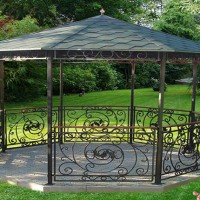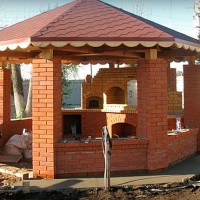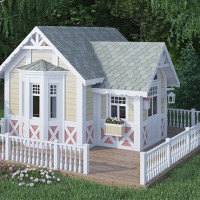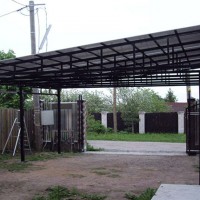We build a polycarbonate gazebo with our own hands: step-by-step instructions, drawings, photos
A good option for a garden, cottage or private home is a polycarbonate gazebo.She looks attractive and respectable. The structure of the material gives the structure strength, reliability and durability. The relatively lightweight material is easy to assemble with your own hands.
The content of the article:
Advantages and disadvantages of polycarbonate gazebos
Light architectural structures are usually installed in gardens and parks, on the territory of a private residential building or in a country house. A gazebo allows you to feel comfortable outdoors. To some extent protects from bad weather: wind, rain, hot sun rays. In this regard, a polycarbonate gazebo is considered an excellent option for relaxation, meetings, dates and conversations.
The main material is polycarbonate, polymer plastic. Until processing, the substance is stored in granules. The synthetic polymer is durable and frost-resistant, lightweight and plastic, and is a dielectric. A variety of polycarbonate for construction are monolithic sheets and honeycomb panels.
A monolithic sheet is characterized by the same structure over its entire area. Its thickness is from 2 to 12 mm. The particularly durable material has a thickness of up to 20 mm. When cut, it looks like ordinary glass. Cellular polycarbonate consists of two thin sheets connected to each other by remote longitudinal partitions, 10 mm thick. They create a kind of honeycomb structure and act as stiffening ribs. The air in the voids acts as a heat insulator.
Both types allow the formation of rounded surfaces, which is impossible to do with glass. However, to create interesting and unusual designs, the bending radius should be taken into account. A similar characteristic is indicated in the technical documentation. Positive properties of polycarbonate:
- lightweight material;
- can be freely cut, drilled and acquired the desired shape;
- does not lose its properties, does not deform;
- light transmittance like glass;
- has high thermal insulation qualities;
- protects against UV radiation;
- 250 times stronger than glass;
- can be matte or transparent;
- has a wide range of colors.
The material is moisture resistant. He is not afraid of insects and mold. In order to optimize quality, additives are introduced into polycarbonate for better light scattering, combustion inhibitor substances, and ultraviolet protection are applied. During manufacturing, the magnitude of thermal expansion is taken into account, and the possibility of “internal rain” is excluded.

Of course, polycarbonate has some disadvantages. In the summer it will be hot in a closed gazebo. Therefore, you need to provide for the possibility of ventilation or make a combined gazebo using wood and metal. The polycarbonate sheet does not absorb noise from rain, unlike the honeycomb structure, which provides good sound insulation. But to make a roof (to withstand heavy rains, hail, and snowfalls) you will need thick, and therefore expensive, sheets.
Polycarbonate sheets are used in the construction of various structures. Suitable for covering large spans and large glass buildings. In case of damage to structures or collapse of ceilings, there is no risk of causing serious injury.It is successfully used in agriculture and medicine, electrical engineering, and the production of advertising products. They especially often cover greenhouses.
Healthy: DIY gazebos made of wood.
Ideas for cottages and gardens
You can purchase a ready-made gazebo, assemble and install it on your site, or build it yourself. A closed gazebo is very popular, as it can be used at any time of the year. It can have hinged or sliding frames and be combined with a summer kitchen. Such a structure requires pouring a foundation.
Open-type structures include a rotunda entwined with roses or grapes, a pavilion, a gazebo, and a gazebo. Simplicity of assembly, excellent quality of the material give free rein to imagination. They allow you to build a gazebo of any size and shape: square, round, polygonal, arched, as well as complex asymmetrical structures of several tiers.
According to the type of installation, gazebos are either stationary or portable. The first ones are usually built on a foundation. The second, with a polycarbonate roof, can be installed on any type of soil, in any corner of the site. It is enough if it is a flat and dry area on a small hill so that rainwater does not accumulate on it.
According to the level of equipment, the gazebo provides for the presence of at least a canopy, a table and two benches, and can have an original configuration, serve not only for eating, be a creative decor, decorate the area, or a place for children's games.
Based on the type of construction, there are simple structures - supports with a canopy. Complex ones have an original irregularly shaped base and a multi-level roof.
Gazebos are small in size, up to 10 m2. They are designed for 4–6 people. Their construction and maintenance are inexpensive.Medium (10–20 m2) will accommodate 10–15 people. Large, more than 20 m2 — essentially it’s a canopy, an open structure. Rectangular or hexagonal in shape. They are used for canteens, boarding houses, holiday homes, and beaches.
To build a gazebo you will need a frame. It is usually made of wood, brick, metal, or profile pipe. Polycarbonate sheets are used to cover the walls and make a roof. A roof made of colored plastic creates the feeling of a sunny day in the cloudiest weather.
Square
The most popular type of gazebo is square or rectangular. It's easier to build it yourself. Straight lines will require a minimum of materials. A roof or canopy made of polycarbonate is installed on poles or frames. Stone or metal elements are used as decorations: carvings, openwork forging.
The most ordinary standard furniture can be successfully placed inside. Square or rectangular summerhouses have dimensions: 2x2; 3x3 m or 2x3; 3x4 m. As for the design, such a gazebo can be decorated in a high-tech or loft style.
Healthy: We build a modern gazebo with a barbecue for the dacha with our own hands.
Round
Gazebos of this shape are also popular, especially unusual options. The advantage of the arched one is its streamlining. The domed one can withstand strong winds. Original open structures in the form of a barrel or hemisphere perform not only a practical function, but also decorate the site.
A polygonal gazebo requires serious calculations, drawings and markings. They can be made without side walls and look great, but the construction time for such structures increases significantly. For this type of construction, finishes in Chinese or Japanese style are chosen.
Step-by-step instruction
A summer gazebo is indispensable in a garden or summer cottage; it allows you to relax comfortably, unwind after hard work, get together with the whole family, and celebrate a holiday. To build the simplest classic gazebo made of polycarbonate, you need to make a drawing or find it on the Internet.
The drawing gives an idea of the dimensions, how the structure will fit on the site, and will allow you to calculate the amount of materials needed. After the components and fittings have been purchased and the tools have been prepared, you can install the building according to the step-by-step instructions.
- Site preparation.
- Assembly and installation of the foundation, supports or frame.
- Cutting polycarbonate to specified sizes.
- Folding the fabric perpendicular to the partitions.
- Roof installation, location and fastening of parts.
- Parapet sheathing.
- Framing polycarbonate with a starting profile.
Next, finishing work and decoration are carried out. When using a metal frame and polycarbonate sheets, a gazebo can be manufactured by a person who does not have significant experience in design and construction.
Interesting: How to build a comfortable metal gazebo with your own hands.
Cutting and fastening of polycarbonate sheets
Polycarbonate is easy to install. It is easy to install and, if necessary, remove. You should remember its technological features. To avoid deformation, care is required when attaching the sheets to the frame. For cutting, use a jigsaw, a hacksaw, or a hand saw. You can use a circular saw with a disc for aluminum. There is practically no waste or spoiled pieces.
If the material was stored in a damp place, it must be blown with air before use.After cutting, cover the ends with aluminum adhesive tape, sealant or trim profile. Do not step on the polycarbonate sheet; installation is carried out only from a ladder.
Choosing a design shape
The garden and country gazebo can be made open or closed. Install in a permanent place or make it collapsible. It all depends on its functionality, time of use (all year round or only during the gardening period), and the number of users. An important aspect is accessibility to purchase the necessary materials, financial ability, and basic skills in construction.
The most acceptable design option for a summer house is a gazebo made of profile plastic pipe and polycarbonate. To use the building all year round, it must be closed. Thanks to the plasticity of the material, it is possible to give it any shape, with different roofing options. It should be remembered that a domed roof is most resistant to loads in the form of snow and rain.
If you add forged elements and make metal barriers, this structure takes on the appearance of a rotunda. Inside you can put a small wooden table and benches.
Tools and materials
Cellular polycarbonate is lighter and cheaper. Monolithic is much more expensive and heavier. The thickness of the material is important. For the reliability of the cladding, a sheet of 8 mm thick is required. To determine its quality, you need to check the specific gravity. The weight of such a monolithic sheet is at least 9.6 kg.
The parameters of the honeycomb sheets are as follows:
- 2100 x 60 mm; 2100 x 120 mm;
- thickness - 4; 6; 8; 10; 16; 20 mm;
- transparent or bronze (colored on request);
- warranty - from 10 years.
Monolithic polycarbonate:
- 2050 x 3050 mm; 2050 x 6100 mm;
- thickness - 2; 4; 6; 8; 10 mm;
- transparent, colored - upon request;
- warranty - 15 years.
Polycarbonate expands when heated, so thermal washers are used for fastening. The end sides of cellular polycarbonate should be isolated from the penetration of water and fumes with special plugs. The protective film that covers both sides of the sheet should not be removed in advance.
The screws must have a hex head with an additional press washer and a rubber gasket. The fasteners should not be over-tightened to prevent cracking of the material. You also need roofing screws or a split profile. For a metal frame, a welded connection or bolting is used.
During construction you will also need nails, screws, nuts and bolts. To process wooden surfaces you need sandpaper, glue, paint, and varnish. The tools you will need are a drill with drills, a screwdriver, screwdrivers, and a hammer. Shovel for installing supports, sand, cement, expanded clay or stones.
Article for you: How to make a gazebo from a profile pipe with your own hands.
Foundation, supports and floor
A polycarbonate gazebo does not require a serious foundation. A monolithic foundation is necessary if it is a permanent structure - brickwork with wooden elements, installation of a fireplace or barbecue. This structure weighs quite a lot. It will require a shallow strip foundation.
Construction begins with site preparation. If there is no floor in the gazebo, the area is leveled, holes are dug and support posts are installed in accordance with the shape of the gazebo and the drawing. Pieces of metal are welded onto metal supports, lowered into a hole and filled with concrete. Horizontal jumpers are welded at a certain height to create railings.The sheathing will subsequently be attached to them. To make the floor, the area is concreted or paving slabs are laid.
Frame and sheathing
Metal is used more often than other materials for the frame. A medium-section profile pipe will make the construction stable and of high quality. A gazebo can be built using two different materials. For example, a timber frame is covered not only with clapboard and siding, but also with polycarbonate. The metal frame is more durable. The blanks are cut before installation, cleaned of rust, and primed. Wooden ones are immediately made on site, treated with antiseptics and fire retardants.
Roof
The roof can be single, gable or domed. If it must follow the contours of the building (hemisphere), polycarbonate simply and effectively solves this problem. A metal sheathing of the desired shape is made. Installation starts from the center. Jumpers are installed between the stiffeners. Next, the roof sheathing is performed. Screw the polycarbonate with self-tapping screws, in increments of 400–500 mm.
Operating rules
For the winter, an open or semi-open gazebo should be covered with an awning, old frames, or wrapped with film or other dense material. There are some recommendations, if followed, that a polycarbonate gazebo will last a long time.
- Rigid fastening to the ground should be ensured to prevent drift during strong winds and storms.
- If it is an open prefabricated structure, it should be disassembled for the winter and stored indoors.
- Protect the frame from mechanical damage.
- To ensure light transmission, the polycarbonate surface must be washed with a cotton cloth and detergent (without ammonia or solvents).
- Do not expose abrasive parts to chemicals.
To be sure that the material will last the period stated by the manufacturer, you need to buy it from reliable suppliers. This is a guarantee that the polycarbonate will not lose its properties, and the gazebo will protect from heat and cold for a long time.
Article for you: We make a gazebo from scrap materials with our own hands.
If there is a gazebo on the site that you built yourself, tell us about the intricacies of its manufacture. Leave a comment, share the article on social networks, bookmark it.

















Tell me how to make a semicircle from a 20x20 pipe for a polycarbonate roof?
The easiest way is to order a semicircle from a workshop. There, the pipe is carefully bent on a pipe bender to the specified dimensions. Alternatively, purchase a pipe bender yourself and bend everything yourself. It's not difficult to use. Alternatively, cuts are made on one side of the pipe (many cuts). The pipe is cut so that only one side remains intact. After this, it easily bends into a semicircle. The pipe must be bent towards the cuts.If their width is not sufficient to obtain the desired radius, then they will have to be expanded or segments cut out altogether. Naturally, all cuts after bending will have to be welded, the seams will have to be cleaned and made invisible. There is plenty of work, if we are not talking about making a single copy of the arc, then it is best to contact a workshop.
How heavy polycarbonate is! The difference between cellular (with air gaps) and monolithic in mass is more than 8 times! The strength of a monolithic material is, of course, higher in every sense. Although cellular material also has its advantages. For example, this is its lightness and flexibility. Can be bent at the desired angle when sheathing roofs or walls. This quality is very valuable; you feel it directly during installation.
I have always believed that a gazebo is a place where you should be as comfortable as possible. The open air is wonderful. But when there is wind outside it is very inconvenient, for example, to have lunch or drink tea in the gazebo. And like this, in a closed gazebo - well, that’s great! Now I want such a gazebo in my dacha!